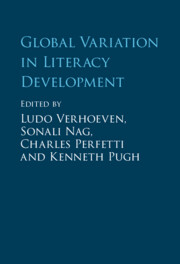Book contents
- Global Variation in Literacy Development
- Global Variation in Literacy Development
- Copyright page
- Contents
- Figures
- Tables
- Contributors
- Abbreviations
- 1 Introduction
- Part I Regional Variations
- Part II Neurobiological and Ecological Markers
- 11 Writing Systems and Global Literacy Development
- 12 Brain Foundations for Learning to Read
- 13 Genetics and Literacy Development
- 14 Role of Self-Regulation in the Transition to School
- 15 Socioeconomic Status, Sociocultural Factors, and Literacy Development
- 16 Sensitivity to Contextual Factors in Literacy Interventions in the Global South
- 17 How Teachers Contribute to Children’s Literacy Success
- 18 The Literacy Ecology of the Home
- 19 Parental Literacy Support in Monolingual and Bilingual Contexts
- 20 Global Literacy
- Index
- References
12 - Brain Foundations for Learning to Read
from Part II - Neurobiological and Ecological Markers
Published online by Cambridge University Press: 23 November 2023
- Global Variation in Literacy Development
- Global Variation in Literacy Development
- Copyright page
- Contents
- Figures
- Tables
- Contributors
- Abbreviations
- 1 Introduction
- Part I Regional Variations
- Part II Neurobiological and Ecological Markers
- 11 Writing Systems and Global Literacy Development
- 12 Brain Foundations for Learning to Read
- 13 Genetics and Literacy Development
- 14 Role of Self-Regulation in the Transition to School
- 15 Socioeconomic Status, Sociocultural Factors, and Literacy Development
- 16 Sensitivity to Contextual Factors in Literacy Interventions in the Global South
- 17 How Teachers Contribute to Children’s Literacy Success
- 18 The Literacy Ecology of the Home
- 19 Parental Literacy Support in Monolingual and Bilingual Contexts
- 20 Global Literacy
- Index
- References
Summary
This chapter aims to unravel the contribution of the neuroscience of reading to the study of literacy development across languages and writing systems. The development of early literacy can be adversely impacted by neurodevelopmental disorders and socioeconomic disparities that have lasting effects on child and adolescent cognition. The goal of this chapter is to address the continuum of literacy development in two critical stages, birth-to-six and six-to-ten years old, and their respective language and brain milestones: the hardwired brain networks for speech, and the adaptation of brain regions for reading. The discussion attempts to disambiguate neurodevelopmental disorders and socioeconomic factors that influence early literacy, and the associated effects on brain function and structure. It is concluded that there is emerging evidence for a near-universal brain system that develops with learning to read across writing systems and the chapter addresses the dynamic relations among brain networks for reading, speech and writing across the two age spans. It is also claimed that the neuroscience of reading has the potential to inform prediction of reading achievement, identification of risk for reading difficulties, and possibly, choice of intervention and of the age ranges that are more amenable to treatment.
- Type
- Chapter
- Information
- Global Variation in Literacy Development , pp. 265 - 291Publisher: Cambridge University PressPrint publication year: 2023

